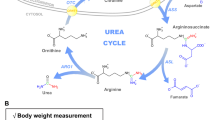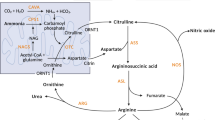Abstract
We have previously examined the clinical manifestations, treatments and prognosis of 177 patients with urea cycle disorders (UCDs) from January 1999 to March 2009 in Japan. In this study, we investigated the incidence of clinical manifestations in different peak blood ammonia level at onset in UCD patients, and examined the growth of OTCD (ornithine transcarbamylase deficiency) patients. The UCD patients who had a high peak blood ammonia level at onset showed significantly high incidence of convulsion and abnormal head computed tomography or magnetic resonance imaging. The patients also showed significantly high incidence of hemodialysis and liver transplantation. Choice of therapeutic agents for long-term treatment is not different between peak blood ammonia levels at the onset, except for the use of special amino-acid formulas. Growth retardation is not affected by high peak blood ammonia level at onset; however, 32% of male and 52% of female OTCD patients over 1 year old were plotted under the 10th percentile, and showed growth failure. The final height of the male and female OTCD patients were 166.2±5.5 and 150.3±7.2 cm, respectively. Although the prognosis of UCDs was improved significantly, it is considered that there are still many difficulties in the UCD patient's life.
Similar content being viewed by others
Log in or create a free account to read this content
Gain free access to this article, as well as selected content from this journal and more on nature.com
or
References
Brusilow, S. W. & Horwich, A. L. in The Metabolic and Molecular Bases of Inherited Disease 8th edn (eds Scriver, C. R., Beaudet, A. L., Sly, W. S. & Valle, D.) 1909 (McGraw-Hill, New York, NY, USA, 2001).
Matsuda, I. & Tanase, S. The ornithine transcarbamylase (OTC) gene: mutations in 50 Japanese families with OTC deficiency. Am. J. Med. Genet. 71, 378–383 (1997).
Brusilow, S. W., Valle, D. L. & Batshaw, M. New pathways of nitrogen excretion in inborn errors of urea synthesis. Lancet 2, 452–454 (1979).
Brusilow, S.W. Phenylacetylglutamine may replace urea as a vehicle for waste nitrogen excretion. Pediatr. Res. 29, 147–150 (1991).
Nagasaka, H., Yorifuji, T., Murayama, K., Kubota, M., Kurokawa, K., Murakami, T. et al. Effects of arginine treatment on nutrition, growth and urea cycle function in seven Japanese boys with late-onset ornithine transcarbamylase deficiency. Eur. J. Pediatr. 165, 618–624 (2006).
Leonard, J. V. The nutritional management of urea cycle disorders. J. Pediatr. 138, S40–S44 (2001).
Feillet, F. & Leonard, J. V. Alternative pathway therapy for urea cycle disorders. J. Inherit. Metab. Dis. 21, 101–111 (1998).
Batshaw, M. L., MacArthur, R. B. & Tuchman, M. Alternative pathway therapy for urea cycle disorders: twenty years later. J. Pediatr. 138, S46–S54 (2001).
Schaefer, F., Straube, E., Oh, J., Mehls, O. & Mayatepek, E. Dialysis in neonates with inborn errors of metabolism. Nephrol. Dial. Transplant. 14, 910–918 (1999).
Uemoto, S., Yabe, S., Inomata, Y., Nishizawa, H., Asonuma, K., Egawa, H. et al. Coexistence of a graft with the preserved native liver in auxiliary partial orthotopic liver transplantation from a living donor for ornithine transcarbamylase deficiency. Transplantation 63, 1026–1028 (1997).
Kido, J., Nakamura, K., Mitsubuchi, H., Ohura, T., Takayanagi, M., Matsuo, M. et al. Long-term outcome and intervention of urea cycle disorders in Japan. J. Inherit. Metab. Dis. 35, 777–785 (2012).
Kido, J., Nakamura, K., Matsumoto, S., Mitsubuchi, H., Ohura, T., Shigematsu, Y. et al. Current status of hepatic glycogen storage disease in Japan: clinical manifestations, treatments and long-term outcomes. J. Hum. Genet. 58, 285–292 (2013).
Smit, G. P. The long-term outcome of patients with glycogen storage diseases. J. Inherit. Metab. Dis. 13, 411–418 (1990).
Nakamura, K., Kido, J., Mitsubuchi, H. & Endo, F. Diagnosis and treatment of urea cycle disorders in Japan. Pediatr. Int. 56, 506–509 (2014).
Maestri, N. E., Brusilow, S. W., Clissold, D. B. & Bassett, S. S. Long-term treatment of girls with ornithine transcarbamylase deficiency. N. Engl. J. Med. 335, 855–859 (1996).
Matsuda, I., Nagata, N., Matsuura, T., Oyanagi, K., Tada, K., Narisawa, K. et al. Retrospective survey of urea cycle disorders: Part 1. Clinical and laboratory observations of thirty-two Japanese male patients with ornithine transcarbamylase deficiency. Am. J. Med. Genet. 38, 85–89 (1991).
Nassogne, M. C., Héron, B., Touati, G., Rabier, D. & Saudubray, J. M. Urea cycle defects: management and outcome. J. Inherit. Metab. Dis. 28, 407–414 (2005).
Uchino, T., Endo, F. & Matsuda, I. Neurodevelopmental outcome of long-term therapy of urea cycle disorders in Japan. J. Inherit. Metab. Dis. 21, 151–159 (1998).
Häberle, J., Boddaert, N., Burlina, A., Chakrapani, A., Dixon, M., Huemer, M. et al. Suggested guidelines for the diagnosis and management of urea cycle disorders. Orphanet J. Rare Dis. 7, 32 (2012).
Acknowledgements
This study was supported, in part, by a Grant-in-Aid for the Promotion of Science and Ministry of Education, Culture, Sports, Science and Technology; a Grant-in-Aid for Pediatric Research from the Ministry of Health, Labor and Welfare; and a Grant-in-Aid for Scientific Research from the Ministry of Education, Culture, Sports, Science and Technology; and a Grant-in-Aid for the research on rare and intractable diseases, Health and Labor Sciences Research. We thank Drs T Ohura, M Takayanagi, M Matsuo, M Yoshino, Y Shigematsu, T Yorifuji, M Kasahara and R Horikawa for data collection and discussion.
Author information
Authors and Affiliations
Corresponding author
Ethics declarations
Competing interests
The authors declare no conflict of interest.
Rights and permissions
About this article
Cite this article
Nakamura, K., Kido, J., Matsumoto, S. et al. Clinical manifestations and growth of patients with urea cycle disorders in Japan. J Hum Genet 61, 613–616 (2016). https://doi.org/10.1038/jhg.2016.17
Received:
Revised:
Accepted:
Published:
Issue date:
DOI: https://doi.org/10.1038/jhg.2016.17
This article is cited by
-
Long-term effects of medical management on growth and weight in individuals with urea cycle disorders
Scientific Reports (2020)



